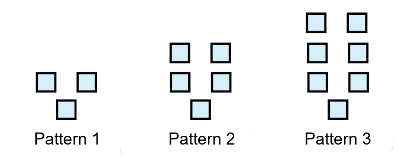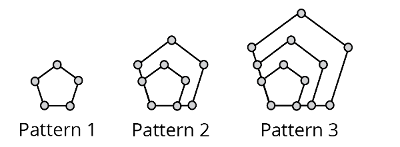Number Patterns: Grouping & Common Difference
Number pattern problems involve a sequence of numbers that are given and we have to identify the patterns in the given sequence and answer the questions.
Number pattern questions can be very challenging. Once you get a hang of it, it can get really interesting.
In this lesson, we will look at solving number pattern problems through
- Grouping, and
- Common difference
Grouping technique is used to solve number patterns where the sequence of numbers is repeated. For instance, there is a sequence in \(1, 3, 4, 2, 1, 3, 4, 2, 1, 3, 4, 2…\)
Common difference method is used where the difference between the consecutive numbers of a sequence remains the same. An example of this sequence would be \(1, 4, 7, 10, 13…\)
Number patterns involving grouping
Let’s try to understand this concept through an illustration.
Example 1:
Tim uses the letters \(\text{E, F, P, O}\) to form a pattern as given below:
\(\text{E P F O E P F O E P F O E P…}\)
Which letter is at the \(\text{34th}\) position?
Solution:
In order to solve this, the first step is to identify a pattern that is repeated.
\(\bbox[yellow]{\text{E P F O }} \bbox[pink]{\text{E P F O }} \bbox[aqua]{\text{E P F O}} \text{ E P ...}\)
We see that the letters \(\text{EPFO}\) are repeated. So a set of \(4\) letters is repeated in the given pattern.
Next, we determine how many sets are there in \(34\) letters.
\(\left. \begin{array}{l} \text{1} & \text{E P F O} \\ \text{2} & \text{E P F O} \\ \text{3} & \text{E P F O} \\ \text{4} & \text{E P F O} \\ \text{5} & \text{E P F O} \\ \text{6} & \text{E P F O} \\ \text{7} & \text{E P F O} \\ \text{8} & \text{E P F O} \\ \end{array} \right\}{\text{8 sets of 4 letters} =32}\\ \quad\;\;\, \text{E P }\)
Number of sets in \(34\) letters\(\begin{align*}\\[2ex] &= 34 \div 4 \\[2ex] &= 8 \text{ sets R 2 letters} \end{align*}\)
The quotient \(8\) tells us the number of times the complete set is repeated.
The remainder \(2\) tells us the position of the required letter.
Hence, the \(\text{34th}\) letter in the pattern will be the letter \(\text{P}\)
Answer:
\(\text{P}\)
Let’s try to solve a few questions to see if you’ve understood the concept of grouping.
Question 1:
Tina uses stickers of four different shapes to make a pattern. The first \(11\) stickers are shown below:

What is the shape in the \(\text{91st}\) position?
Solution:
Firstly, let’s identify the repeating group in the pattern. How many shapes form the repeating group?

As you can see, a group of \(4\) shapes forms a repeated pattern.
(square, triangle, circle, and trapezium)
So, \(1\) complete set consists of \(4\) shapes.
Next, let us determine the number of complete sets \(91\) shapes can form.
Number of sets in \(91\) shapes \(\begin{align*} \\[2ex] &= 91 \div 4 \\[2ex] &= 22 \text{ sets R 3 shapes} \end{align*}\)
Since we have remainder \(3\), the shape in the \(\text{91st}\) position will be the \(\text{3rd}\) shape in the repeating pattern. So the correct answer is:

Answer:

Question 2:
A number sequence is shown below:
\(\text{6 1 6 8 5 6 1 6 8 5 6 1 6 8 5…}\)
- What is the \(\text{227th}\) number?
- What is the sum of the first \(104\) numbers?
Solution:
To get the \(\text{227th}\) number, let's follow the steps we have learned so far.
Step 1:
Identify the repeating group or set.
\(\bbox[yellow]{\text{6 1 6 8 5 }} \bbox[pink]{\text{6 1 6 8 5 }} \bbox[aqua]{\text{6 1 6 8 5}} \text{ ...}\)
So a set of \(5\) numbers ‘\(\text{6 1 6 8 5}\)’ is repeated.
Hence, one complete set consists of \(5\) numbers.
Step 2:
Let us determine the number of complete sets \(227\) numbers can form.
Number of sets in \(227\) numbers\(\begin{align*} \\[2ex] &= 227 \div 5 \\[2ex] &= 45 \text{ sets R 2 numbers} \end{align*}\)
Since we have remainder \(2\), therefore the number in the \(\text{227th}\) position will be the \(\text{2nd}\) number in the repeating pattern. So the correct answer is ‘\(1\)’.
Answer:
\(1\)
- To solve the second part, let’s break down the problem into smaller steps.
Step 1:
What is the sum of the numbers in \(1\) complete set?
One set is \(\text{6 1 6 8 5}\).
Sum of numbers in \(1\) complete set \(\begin{align*} \\[2ex] &= 6 + 1 + 6 + 8 + 5 \\[2ex] &= 26 \end{align*}\)
Step 2:
Find the number of complete sets in \(104\) numbers.
Number of sets in \(104\) numbers\(\begin{align*} \\[2ex] &= 104 \div 5 \\[2ex] &= 20 \text{ sets R 4 numbers} \end{align*} \)
Step 3:
Calculate the sum of the first \(104\) numbers.
\(104\) numbers consist of \(20\) complete sets and an additional \(4\) numbers.
Sum of first \(20\) sets of numbers \(\begin{align*} \\[2ex] &= 20 \times 26 \\[2ex] &= 520 \end{align*}\)
Sum of first \(104\) numbers \(\begin{align*} \\[2ex] &= 520 + 6 + 1 + 6 + 8 \\[2ex] &= 541 \end{align*}\)
Answer:
\(541\)
Number patterns involving common difference
Question 1:
Consider the pattern sequence shown below:

- How many square tiles are there in the \(\text{25th}\) pattern?
Solution:
In such sequences, the first thing we do is to identify a pattern.
In the above figure we observe that when we move from any one pattern to the next one, there is a common difference of \(2\) tiles.
Hence the method of solving is ‘Common Difference’.
| Number of square tiles in pattern 1 |
\(=3\) | Number of times '\(2\)' added \(= 0\) |
| Number of square tiles in pattern \(\color{red}{ 2}\) |
\(= 3 + 2\) | Number of times '\(2\)' added \(= \color{red}{ 1}\) |
| Number of square tiles in pattern \(\color{red}{ 3}\) |
\(= 3 + 2 +2\) | Number of times '\(2\)' added \(= \color{red}{ 2}\) |
| Number of square tiles in pattern \(\color{red}{ 4}\) |
\(= 3 + 2 + 2 + 2\) | Number of times '\(2\)' added \(= \color{red}{ 3}\) |
Note that the number of times ‘\(2\)’ gets added is \(1\) less than the pattern number.
| Number of square tiles in pattern 25 |
\(= 3 + 24 \times 2 \\ = 51 \) | Number of times '\(2\)' added \(= 25-1 \\ = 24\) |
Answer:
\(51\)
- In the above sequence, find the pattern number in which \(399\) square tiles were used.
Solution:
In the above working, we had determined that,
Number of square tiles \(= 3 + \text{( Pattern number} - 1\,) \times 2\)
To find the pattern number with \(399\) square tiles,
\(\begin{align*} 399 - 3 &= 396 \\[2ex] 396 \div 2 &= 198 \\[2ex] 198 + 1 &= 199 \end{align*}\)
The pattern number is \(199\).
Answer:
\(199\)
Question 2:
The pattern below shows a series of pentagons made of beads and strings.

- How many beads are there in Pattern \(5\)?
Solution:
Number of beads in Pattern \(1 = 5\)
Number of beads in Pattern \(2 = 5 + 4\)
Number of beads in Pattern \(3 = 5 + 4 + 4\)
Therefore,
Number of beads \(= 5 + \text{( Pattern Number} - 1\,) \times 4\)
Number of beads in Pattern \(5 \)
\(\begin{align*} &= 5 + (5 - 1) \times 4 \\[2ex] &= 5 + 4 \times 4 \\[2ex] &= 5 + 16 \\[2ex] &= 21 \end{align*}\)
Answer:
\(21\)
- In which pattern will there be \(253\) beads?
Solution:
From above working we have figured out that,
Number of beads \(= 5 + \text{( Pattern Number} - 1\,) \times 4\)
To find the pattern with \(253\) beads,
\(\begin{align*} 253 - 5 &= 248 \\[2ex] 248 \div 4 &= 62 \\[2ex] 62 + 1 &= 63 \end{align*}\)
Pattern \(63\) has \(253\) beads.
Answer:
\(63\)
- Andy wants to make a pattern consisting of \(43\) pentagons. Given that he has \(151\) beads, how many more beads does he need?
Solution:
Let us first find the relationship between Pattern Number and the Number of pentagons.
Number of pentagons in Pattern \(1 = 1 \)
Number of pentagons in Pattern \(2 = 2 \)
Number of pentagons in Pattern \(3 = 3 \)
Therefore, as a general rule, we find that
Pattern Number \(=\) Number of pentagons
Hence, a pattern having \(43\) pentagons is pattern \(43\).
Now, in (a) we determined that,
Number of beads \(= 5 + \text{( Pattern Number} - 1\,) \times 4\)
Number of beads in Pattern Number \(43\)
\(\begin{align*} &= 5 + (43 - 1) \times 4 \\[2ex] &= 5 + 42 \times 4 \\[2ex] &= 5 + 168 \\[2ex] &= 173 \end{align*}\)
Number of beads Andy had at first \(= 151\)
\(173 - 151 = 22\)
Andy needs \(22\) more beads to make the pattern of \(43\) pentagons.
Answer:
\(\text{22}\)
Conclusion
In this article, we learnt about number patterns involving grouping and common differences.
- Grouping
In number patterns involving grouping, we group the patterns into sets. To find the letter or object in a specific position, we will need to do division. The quotient will tell us the number of times the complete set appears. The remainder will tell us the position of the letter or object in the set.
- Common Difference
In number patterns involving common differences, we need to first identify what is the difference between each pattern. From there, we find a formula for the total, given the pattern number and vice versa.
| Continue Learning | |
|---|---|
| Algebra | Distance, Speed and Time |
| Volume of Cubes and Cuboid | Fundamentals Of Pie Chart |
| Finding Unknown Angles | Number Patterns: Grouping & Common Difference |
| Fractions Of Remainder | Fractions - Division |
| Ratio | Repeated Identity: Ratio Strategies |
 SG
SG  VN
VN 











